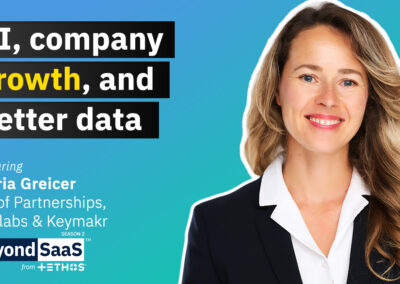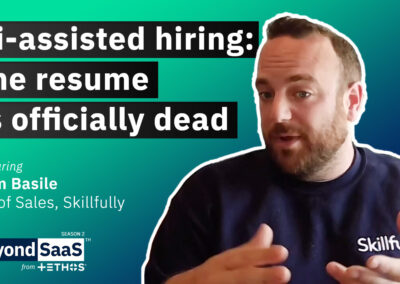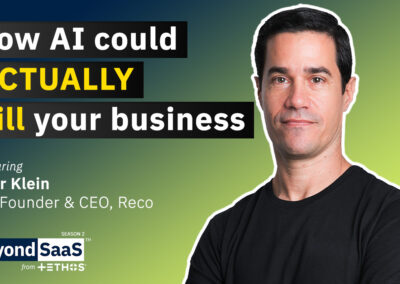Venture capitalist Chris Rigatuso discusses the challenges mid-stage tech companies face in growth, particularly focusing on market segmentation and the evolution of customer relationship management (CRM). He emphasizes the importance of refining market segments, understanding customer needs, and leveraging domain experience to drive growth. Chris also touches on emerging trends in the tech landscape and shares insights from his upcoming book on securing funding for startups.
Takeaways
- CRM is a foundational tool for startups that evolves over time.
- Market segmentation is crucial for identifying growth opportunities.
- Companies often plateau after initial success due to unclear segmentation.
- Refining segments can lead to better sales qualification and success.
- Understanding customer needs is essential for product development.
- Domain experience enhances credibility and effectiveness in sales.
- Emerging trends like AI will impact employment and market dynamics.
- Investors look for live evidence of growth and customer engagement.
- Effective CRM practices lead to better alignment across teams.
- Adjacency in market segments can open new growth avenues.
Show Notes
BeyondSaaS Transcript
Jason Niedle
Today, we’ve got a very special guest—venture capitalist Chris Rigatuso from Archaspace. We’re talking about how mid-stage tech companies can continue growing—and why market segmentation must evolve for that to happen.
Welcome to Beyond SaaS, Chris! Before we jump in, have you got a golden nugget for us?
Chris Rigatuso
Yes—CRM, or customer relationship management, is a simple starting point for any startup. But as a company grows and learns more about its customers and products, CRM becomes much more. It’s a platform that expands across the life of the company, not just a sales tool.
Jason Niedle
Love that. Mine is a little more basic—I’m using a Withings watch instead of an Apple Watch. It looks like a normal watch, but it tracks my sleep, steps, oxygen, and heart rate, and only shows me text messages. It’s a nice break from information overload.
So, quick intro: Chris is a founding partner of Archaspace, a venture capitalist, startup advisor, MBA from Berkeley, and—fun fact—an accomplished musician.
Chris, something I see often: companies push hard to get to $7M–$12M ARR, then hit a plateau. They feel stuck and unsure of how to keep growing. Have you seen that? What’s happening there?
Chris Rigatuso
Definitely. That’s often a marketing problem in the broad sense—which includes sales, messaging, delivery, positioning, and segmentation. Most companies start with one defined segment—say healthcare or manufacturing—but then things stall.
That’s because they’re either:
- Not evolving their segment to become a larger category with network effects and referrals, or
- They don’t fully understand the differences between companies within that segment.
Jason Niedle
So segmentation isn’t static. It has to evolve, right?
Chris Rigatuso
Exactly. Every company hits barriers. Sometimes they’ve nailed a piece of the problem, but customers want the whole thing solved. That’s when segmentation becomes critical.
A “segment” might start broad—like healthcare insurance—but within that, companies differ in priorities, processes, technology stacks, and budgets. Understanding that nuance is key.
Jason Niedle
So what happens when a company hits that plateau? How should they evolve their segmentation?
Chris Rigatuso
Two paths:
- Refine the existing segment. For example, not just healthcare insurance, but those using Oracle Financials—that might be your sweet spot.
- Or, expand into an adjacent segment—maybe healthcare facilities or real estate. But you have to understand that adjacency deeply:
- Do they respect each other as references?
- Do they use similar tech or processes?
- Is the ROI measured similarly?
You need a bridge between segments—and that’s a marketing and messaging challenge.
Jason Niedle
So the idea is: refine your current niche, or expand into the next adjacent one—but do it thoughtfully.
Chris Rigatuso
Exactly. And the more salespeople you have, the more clarity you get. If multiple reps report the same friction, it tells you something. But if it’s just one rep saying, “we’re stuck,” the issue may be the rep, not the segment.
Jason Niedle
Can you walk us through your segmentation framework?
Chris Rigatuso
Sure. I use a six-level segmentation drill-down:
- Separable – Can you clearly define the segment? Are there boundaries?
- Quantifiable – Can you count the companies, revenue, employees, etc. in that segment?
- Testable – Can you validate assumptions over time? Are you collecting data quarterly, not just once?
- Externally Targetable – Can you find them through tools like Datanyze? Can you identify key tech stacks (like Oracle)?
- Hypothesis-Driven – Are you testing assumptions, like who the buyer is or what integrations matter?
- Trackable – Are you logging this in your CRM? Not just contact info, but why they buy, what they like, what they don’t.
Jason Niedle
So if your CRM tracks customer reactions, preferences, and objections—not just names and emails—you can actually learn from your pipeline.
Chris Rigatuso
Exactly. But that requires good CRM hygiene—sales management needs to enforce consistent, meaningful data entry. Even with just 2–3 reps, that insight improves go-to-market alignment.
Jason Niedle
Do you look for this when evaluating companies for funding?
Chris Rigatuso
Absolutely. The best companies show live data, not just pitch decks. They can show their CRM, how it’s changed month over month, what’s working, what’s not. That earns credibility—and ultimately investor confidence.
Jason Niedle
Let’s say you walk into a company and want to assess their segmentation. What do you do?
Chris Rigatuso
Most of the companies I talk to are Seed to Series A. They’re often still in their first segment and haven’t plateaued yet—they’re waiting for their curve to steepen.
So I look for:
- The depth of understanding around their segment
- The strength of their references
- Alignment between their sales pitch and customer interviews
If the founders, product, and customer all tell the same story—that’s golden. But if they don’t, we’ve got a trust and strategy problem.
Jason Niedle
That’s like cross-examining witnesses in a courtroom. Everyone’s story needs to match.
Chris Rigatuso
Exactly. Pitch decks are just your first impression. Real proof is in consistency across demos, data, and customer stories.
Jason Niedle
What separates the companies doing this well from those that don’t?
Chris Rigatuso
Domain experience. Companies that do well have leaders or advisors who deeply understand the industry they’re selling into. They’ve walked in the customers’ shoes.
If no one on the team has worked in the target industry—or they haven’t updated their knowledge in 5+ years—it’s a red flag. You need current, relevant insights from people who’ve lived it.
Jason Niedle
What’s your top advice for leadership teams trying to grow beyond their current segment?
Chris Rigatuso
Two things:
-
Hire for domain experience
If you lack industry depth, get it—through hiring, advisors, or board members. You’ll gain insights, language fluency, and trust with buyers. -
Evolve your CRM
Series A companies usually start with simple CRMs. But to scale, they need to track:- Why deals close or stall
- What integrations matter
- Who the real buyer is
- What objections arise
That insight connects your sales, marketing, and product teams and keeps everyone aligned on what actually matters.
Jason Niedle
Earlier, you gave a great analogy about CRM and rope.
Chris Rigatuso
Yeah—CRM is a tool, like rope. For centuries, rope has solved many problems: building pyramids, pulling sleds, climbing mountains.
The lesson? Don’t be afraid to use a bigger rope as your problems get bigger. Evolve your CRM. Don’t treat it as a single-purpose tool.
Jason Niedle
So smart. Did we miss anything?
Chris Rigatuso
Just that segmentation has many forms. Beyond industry names or NAICS codes, look at:
- Technographics – what tools they use
- Demographics – who their customers are
- Psychographics – brand values or premium/low-cost strategies
- Behavioral – how they make decisions
Start simple. But as you grow, layer in what matters most for your product and your customer journey.
Jason Niedle
Brilliant. Quick bonus round—what trends are you watching in the coming year?
Chris Rigatuso
A few:
- Employment shifts driven by AI and automation
- State-level policy changes—states are diverging from federal trends
- Segmentation by geography will matter more than ever
- And AI adoption will have spillover effects on hiring and software spending
Jason Niedle
Awesome. Tell us about your book.
Chris Rigatuso
The working title is Getting Funded. It’s a guide to building investor conviction—how to orchestrate your team, proof points, and messaging to increase your chances of funding.
It’s based on 300+ evaluations and 30 investments I’ve made. Should be out later this year!
Jason Niedle
We’ll have you back when it’s ready. Where can people find you?
Chris Rigatuso
Best place is LinkedIn. Just search for Chris Rigatuso, or check out Archaspace.com—though the site’s a little outdated at the moment.
Jason Niedle
Chris Rigatuso from Archaspace—thank you for joining Beyond SaaS. For all the listeners, if you’re leading a mid-stage tech company and want to grow, leave us your questions and feedback. And of course, likes and subscribes help a ton.
Until next time—this is Beyond SaaS.




